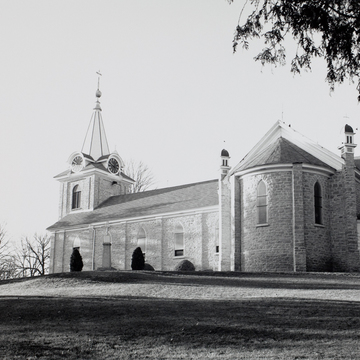The touchstone of Spillville's architecture is Saint Wenceslaus Roman Catholic Church, said by tradition to have been modeled after Saint Barbara's Church in Kutna-Hora, Czechoslovakia. The stone church building of cruciform plan lies low on a hilltop site. Set in the chevet of the church is a small-scaled chapel in the form of a classical temple.
Though the church's windows are pointed, the general detailing and proportions are classical. The interior consists of an aisleless nave, and the 1876 pipe organ still sits on the balcony. On the grounds of the church is a gateway of stone piers and iron which commemorates the jubilee of the church in 1910. In the adjoining cemetery are a number of cast-iron grave markers produced by a local craftsman, Charles Anders, between 1880 and 1920.

